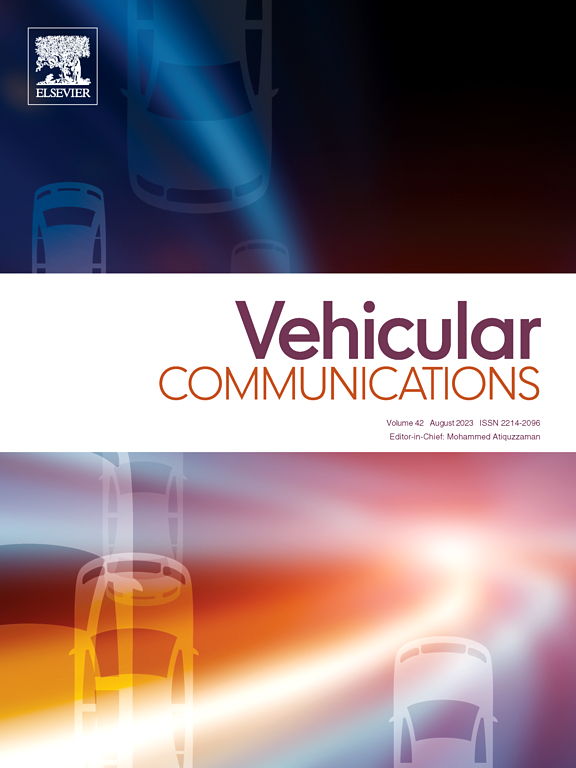增强vanet的安全性:基于自适应秃鹰搜索优化的多智能体深度Q神经网络用于Sybil攻击检测
IF 6.5
2区 计算机科学
Q1 TELECOMMUNICATIONS
引用次数: 0
摘要
目前,车辆自组织网络(VANETs)的使用在收费管理系统和交通控制中得到了极大的关注。vanet通过连接路边单位(rsu)和车辆来促进有效的通信。VANETs可以简化驾驶员的决策,但由于其经常修改拓扑结构,因此存在一些安全问题。在VANET中,Sybil攻击是一种特定的攻击,可能会导致交通拥堵,影响交通安全服务。在VANET中实现了不同的机制来发现各种攻击,但VANET也会遇到各种攻击。为此,本文开发了一种有效的Sybil攻击检测模型,即基于自适应秃鹰搜索优化(ABESO)的多智能体-深度Q神经网络(MA-DQN)。基于ABESO的DQN的主要目标是通过识别Sybil攻击来提高VANET的安全级别。在此过程中,通过聚类和有效的簇头选择来发现Sybil攻击。提出的基于ABESO的DQN算法进行鲁棒聚类,利用BIRCH聚类技术对VANET的车辆节点进行聚类。我们提出的基于ABESO的DQN算法通过有效的簇头选择提高了整体网络效率。利用基于泰勒的水轮装置(TWP)进行簇头选择,降低了网络开销。在提出的模型中,基于mdqn的方法选择特征,基于ABESO的DQN提供最优输出,即发现正常攻击和Sybil攻击。实验结果是基于包含多个攻击数据的符号攻击检测数据集进行的。检测结果证实了基于ABESO的DQN方法的效率优于先前的方法。本文章由计算机程序翻译,如有差异,请以英文原文为准。
Enhancing security in vanets: Adaptive Bald Eagle Search Optimization based multi-agent deep Q neural network for Sybil attack detection
Currently, the use of Vehicular Ad-Hoc Networks (VANETs) has gained significant attention in toll management systems and traffic control. VANETs facilitate effective communication by connecting Roadside Units (RSUs) and vehicles. VANETs can ease decision-making for drivers, meanwhile, they carry some problems with security since they often modify topology. In VANET, the Sybil attack is a specific attack, that might generate traffic congestion and affect transportation safety services. Different Mechanisms have been implemented to discover various attacks in VANET, yet VANET meets diverse attacks. Therefore, this research article developed an effective Sybil attack detection model namely Adaptive Bald Eagle Search Optimization (ABESO) based Multi-agent-Deep Q Neural network (MA-DQN). The principal objective of the ABESO based DQN is to enhance the security level of VANET by identifying the Sybil Attacks. In this, clustering and effective cluster head selection are performed to discover the Sybil attacks. In the suggested ABESO based DQN algorithm, robust clustering is carried out, in which vehicle nodes of VANET are clustered through the utilization of the BIRCH clustering technique. Our proposed ABESO based DQN algorithm augments the overall network efficiency by effective cluster head selection. Taylor-based Waterwheel Plant (TWP) is exploited in the cluster head selection and diminishes the overhead in the network. In the proposed model, the MDQN-based approach selects the features and ABESO based DQN delivers an optimal output, i.e., it discovers normal and Sybil attacks. Experimental results are carried out on the basis of the sybil attack detection dataset that holds multiple data regarding attacks. The detection results affirm that the efficiency of the proposed ABESO based DQN approach is superior and outperformed previous methods.
求助全文
通过发布文献求助,成功后即可免费获取论文全文。
去求助
来源期刊

Vehicular Communications
Engineering-Electrical and Electronic Engineering
CiteScore
12.70
自引率
10.40%
发文量
88
审稿时长
62 days
期刊介绍:
Vehicular communications is a growing area of communications between vehicles and including roadside communication infrastructure. Advances in wireless communications are making possible sharing of information through real time communications between vehicles and infrastructure. This has led to applications to increase safety of vehicles and communication between passengers and the Internet. Standardization efforts on vehicular communication are also underway to make vehicular transportation safer, greener and easier.
The aim of the journal is to publish high quality peer–reviewed papers in the area of vehicular communications. The scope encompasses all types of communications involving vehicles, including vehicle–to–vehicle and vehicle–to–infrastructure. The scope includes (but not limited to) the following topics related to vehicular communications:
Vehicle to vehicle and vehicle to infrastructure communications
Channel modelling, modulating and coding
Congestion Control and scalability issues
Protocol design, testing and verification
Routing in vehicular networks
Security issues and countermeasures
Deployment and field testing
Reducing energy consumption and enhancing safety of vehicles
Wireless in–car networks
Data collection and dissemination methods
Mobility and handover issues
Safety and driver assistance applications
UAV
Underwater communications
Autonomous cooperative driving
Social networks
Internet of vehicles
Standardization of protocols.
 求助内容:
求助内容: 应助结果提醒方式:
应助结果提醒方式:


